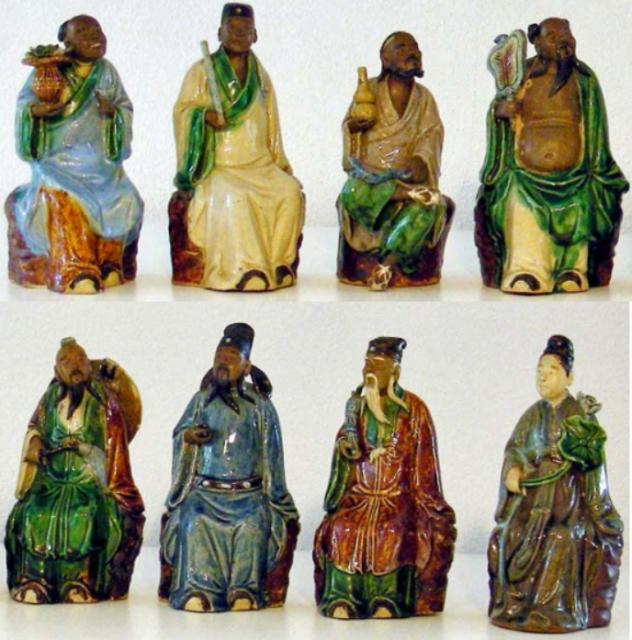Jan Wesselingh was an employee of Netherlands Harbour Works Co. from Amsterdam, working in Guangzhou (Canton) before WWII and in Hong Kong after WWII. I was brought in contact with two of his sons by Theodor A.R. Strauss, 1988-1993 secretary of Nederlandse Reünisten Vereniging China (NRCV, Dutch Reunists Association China), of which Jan Wesselingh was a member.
Can you please help to find out more about the meaning of the figurines?
More narrative will follow.
Courtesy Wesselingh family archives
Source: This image came from Flickr, see https://flickr.com/photo.gne?id=48848406628
Date picture taken
1937
Gallery
Shows organisation(s)

Comments
Figurines
They look like characters from an ancient Chinese novel 水滸傳, which has been translated into several languages over the years. One English version was named "Outlaws of the Marsh" by Sidney Shapiro. The woman figurine with a lotus leaf is likely 潘金蓮, as 蓮 is lotus. The novel is literally a long story, with lots of complex characters and storylines, never had the time nor the inclination to go through it.
Wesselingh family archives: figurines showing seven wise men and
Dear tkjho,
Thank you for your reply, most interesting. I found the book on wikipedia, https://en.wikipedia.org/wiki/Water_Margin , "Water Margin (Chinese: 水滸傳; pinyin: Shuǐhǔ Zhuàn), also translated as Outlaws of the Marsh, Tale of the Marshes, All Men Are Brothers, Men of the Marshes or The Marshes of Mount Liang, is a Chinese novel attributed to Shi Nai'an. Considered one of the Four Great Classical Novels of Chinese literature, the novel is written in vernacular Chinese rather than Classical Chinese.
The story, set in the Song dynasty, tells of how a group of 108 outlaws gather at Mount Liang (or Liangshan Marsh) to form a sizable army before they are eventually granted amnesty by the government and sent on campaigns to resist foreign invaders and suppress rebel forces. It has introduced to readers many of the best-known characters in Chinese literature, such as Wu Song, Lin Chong and Lu Zhishen."
It could be that the figurines refer to the outlaws of the march. I understand that the figurines were given to Jan and Mieke Wesselingh by their housekeeper, Ah-Lin, who worked for them in Huangpu District, Guangzhou at the time and later moved with them to Hong Kong. It was supposedly a gift by Mrs Ah-Lin to the parents of the new-born baby, their eldest son. The figurines were referred to as "seven wise men and a woman". Does anyone know if the part of the seven wise men can be linked to Water Margin / Outlaws of the Marsh? Or perhaps to something else?
Kind regards,
Pieter
They are NOT characters of
They are NOT characters of the Water Margin!
We have Pat Sin Leng in the New Territories. The figurines are those PatSins (八仙)-the famous '8 Immortal Fairies' in Chinese myths. Go to Wiki: Pat Sin Leng to see how the 8 peaks are named after these 8 Chinese fairies, (The translations of their names are not perfect; I've changed some of them)
The figurines:
1st row (L tpo R):
Lan Caihe 藍采和
Han Xiang 韓湘子
Iron-Crutch Li 鐵拐李
Zhongli Quan 漢鍾離
2nd row (L to R):
Lü Dongbin 呂洞賓
Emporer's Brother-in-Law Cao 曹國舅
Elderly Zhang Guo 張果老
Immortal Lady He 何仙姑
Figurines
Stanislaus,
Of course, you're dead on. I never read through any of these Chinese fables, got to know them by bits and pieces here and there, and got the characters all mixed up.
BTW, the name Ah-Lin 亞蓮 of the amah that gifted the figurines also means lotus.
Wesselingh family archives: figurines showing Eight immortal fai
Dear Stanislaus, dear tkjho,
Many thanks for sharing the meaning of the figurines and the name of the housekeeper, I appreciate it. Read the wikipedia page with interest: https://en.wikipedia.org/wiki/Pat_Sin_Leng "Pat Sin Leng is a mountain range in the northeast New Territories of Hong Kong, located within the Pat Sin Leng Country Park. The name Pat Sin Leng literally means "Ridge of the Eight Immortals", who are famous xian ("immortals; transcendents; fairies") in Chinese Mythology, and symbolizes the eight peaks along the Pat Sin Leng mountain range, each named after a different Immortal."
Kind regards,
Pieter